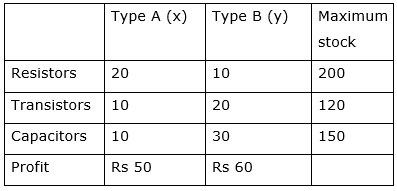A manufacturer of electronic circuits has a stock of 200 resistors, 120 transistors and 150 capacitors and is required to produce two types of circuits A and B. Type A requires 20 resistors, 10 transistors and 10 capacitors. Type B requires 10 resistors, 20 transistors and 30 capacitors. If the profit on type A circuit is Rs 50 and that on type B circuit is Rs 60, formulate this problem as a LPP so that the manufacturer can maximise his profit.
Let the manufacturer produces x units of type A circuits and y units of type B circuits. We make the following table from the given data:

Thus according to the table, the profit becomes, Z=50x+60y
Now, we have to maximize the profit, i.e., maximize Z=50x+60y
The constraints so obtained, i.e., subject to the constraints,
20x+10y≤ 200 [this is resistor constraint]
Now will divide throughout by 10, we get
⇒ 2x+y≤ 20…………..(i)
And 10x+20y≤ 120 [this is transistor constraint]
Now will divide throughout by 10, we get
⇒ x+2y≤ 12…………..(ii)
And 10x+30y≤ 150 [this is capacitor constraint]
Now will divide throughout by 10, we get
⇒ x+3y≤ 15…………..(iii)
And x≥0, y≥0 [non-negative constraint]
So, maximize profit, Z=50x+60y,
subject to 2x+y≤ 20,
x+2y≤ 12
x+3y≤ 15
x≥0, y≥0